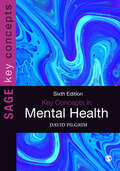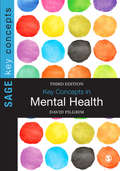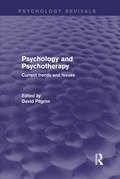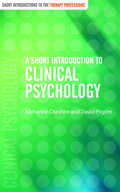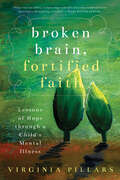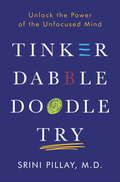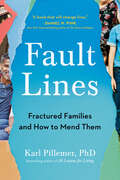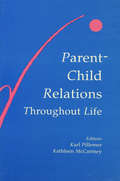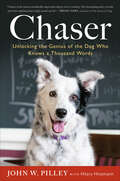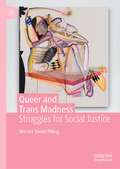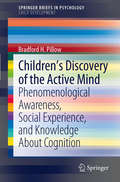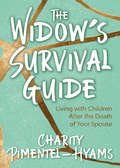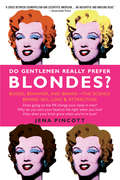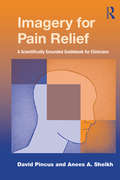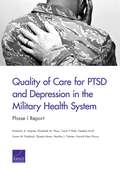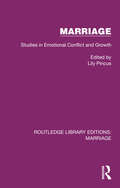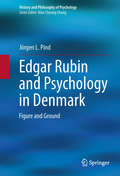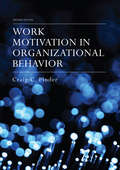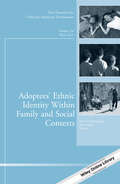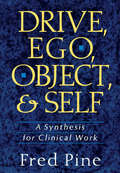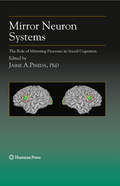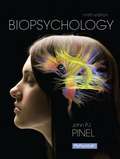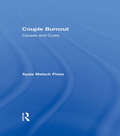- Table View
- List View
Key Concepts in Mental Health (SAGE Key Concepts series)
by David PilgrimA classic and long-trusted resource that provides short summaries of all the key theories, concepts and terminology associated with mental health. Each entry is neatly summarised and thoroughly referenced giving the reader an immediate and thorough entry point to the subject. Structured into four sections, the text starts with entries related to Mental Health and Mental Abnormality, before moving onto Mental Health Services and Society. The new edition offers: 70 concise chapters including new entries on social networks and loneliness Updates across all chapters to align with contemporary, critical debates in mental health Appropriate consideration of the intersection of Covid-19 and mental health An essential guide for students of mental health studies, health, nursing, social work, education, psychology, counselling and psychotherapy.
Key Concepts in Mental Health
by David Pilgrim"This book wins on two levels: not only is there an extensive range of concepts presented (including some that are unexpected yet clearly relevant), there is also a succinct, thorough and critical dissection of each. Recommended, if not essential, reading for all student mental health professionals. " - Dr Steven Pryjmachuk, Head of Mental Health Division, School of Nursing, Midwifery and Social Work, University of Manchester Mental health is an area that new students and trainee practitioners often find bewildering. This book cuts through the stigma associated with this topic. It delivers bite-sized chunks of information that cover the central concepts and debates which shape contemporary views about mental health and illness. As this book shows, these key concepts not only influence our understanding of mental health, but also govern the provision of services for people with mental-health problems. Drawing together perspectives from sociology, psychiatry, psychology and ethics, the vital topics in mental health are examined in three parts: - PART ONE: Mental Health and Mental-Health Problems explores theories and understandings of mental health and illness - PART TWO: Mental Health Services looks at the structure and organization of mental health service delivery, past and present - PART THREE: Mental Health and Society studies the social context. This new edition adds 10 new concepts as well as updating the previous entries. New topics include childhood adversity, recovery, spirituality, well-being, social and cultural capital, quality of mental-health services, evidence-based practice, and work and mental health. This book will be invaluable for trainee health professionals, including clinical psychologists, social workers, nurses, counsellors and psychotherapists.
Key Concepts in Mental Health
by David PilgrimThis is the only text to give you a complete, concise overview of mental health and all the issues that surround it from a theoretical and practical point of view. Split into three sections, the book defines mental health and mental illness, examines the services and settings in which mental health care takes place and discusses the societal issues surrounding mental health. Made up of 63 bite-sized chapters, the book offers: · Definitions of the key concepts · Key points that you need to know for your study and practice · Further reading to help you expand your knowledge It will be essential reading for students of health, nursing, mental health, social work and social care. It is also valuable reading for students of counselling and psychotherapy.
Psychology and Psychotherapy: Current Trends and Issues (Psychology Revivals)
by David PilgrimOriginally published in 1983, fifteen well-known psychologists and psychotherapists write about their personal interests to give the reader a vivid picture of the complexities of psychotherapy in Britain at the time. They explore aspects of the interaction and intersection of the psychological and psychotherapeutic worlds, paying particular attention to the practical and theoretical controversies involved in this overlap. The first half of the book concerns itself with problems of theory and practice in psychology and psychotherapy, while the second half deals with professional conflicts and political issues impinging upon the practice of psychotherapy by psychologists. Areas of concern and controversy that are scrutinised include the problematic relationship between academic psychology and psychotherapy; doubts and certainties in psychotherapy; the psychology of helping; the relevance of the psychodynamic tradition; inter-professional disputes; women and psychotherapy; and social class issues in psychotherapy.
A Short Introduction to Clinical Psychology (Short Introductions to the Therapy Professions)
by David Pilgrim Katherine CheshireA Short Introduction to Clinical Psychology gives an accessible overview of the field for psychology students and anyone considering training as a clinical psychologist. Setting out the theoretical and practical dimensions of clinical psychology, the authors examine its origins, knowledge base and applications with different client groups, in different contexts and through different modalities (individuals, groups, couples, families and organizations). They also highlight issues affecting everyday practice - from professional relationships to government policy. Drawing on the first-hand experiences of people who have recently qualified, the book describes the process of training and the transition that takes place from trainee to practitioner. Throughout, the book captures a sense of clinical psychology as a dynamic and changing field which has grown up fast alongside other more established professions involved in mental health care and which is continuing to evolve in response to contemporary needs. As an overview of the field, A Short Introduction to Clinical Psychology is an ideal text for undergraduate and post-graduate students in psychology and as initial reading for clinical psychology courses.
Discourse, Dialogue and Technology Enhanced Learning
by Rachel PilkingtonDiscourse, Dialogue and Technology Enhanced Learning is invaluable to all those wanting to explore how dialogic processes work and how we facilitate them. Dialogue is an important learning tool and it is by understanding how language affects us and how we use language to encourage, empathise, inquire, argue and persuade that we come closer to understanding processes of change in ourselves and our society. Most researchers in Education will find themselves interpreting some form of data in the form of words; whether these words be explanations, conversations, narrations, reflections, debates or interviews and whether they are conducted through digital media or face-to-face. Discourse, textual or spoken, is therefore central to researching education. Each chapter focuses on the ways in which alternative levels of discourse analysis provide tools for the researcher, enabling insights into the way language works in learning, teaching practice and wider society. Drawing on the author's own 'DISCOUNT' discourse analysis coding scheme and including a wide range of dialogue examples, this book covers: Why Dialogue? The Role of Dialogue in Education. Debate: Learning to Argue and Arguing to Learn Towards Meaning-Making: Inquiry, Narrative and Experience The Role of the Significant Other: Facilitation, Scaffolding and Mediation Inclusion, Collaboration and Community Media, Mode and Digital Literacy Researching Voices and Texts Discourse, Dialogue and Technology Enhanced Learning will be an essential resource for all students, educators and educational researchers who have an interest in the role of discourse in educational contexts.
Broken Brain, Fortified Faith: Lessons of Hope through a Child's Mental Illness
by Virginia PillarsThe terms "mental illness” and “mental health” are often used casually, but many don’t believe mental illness is relevant to their lives. However, studies show that more people live with mental illness than heart disease, lung disease, and cancer combined. Broken Brain, Fortified Faith is the story of one family’s journey through schizophrenia, navigating the uncharted waters of mental illness to find help for their daughter, Amber, and support for their family. This memoir is an honest look at the stress, anger, education, and finally, hope experienced through eyes of a mother. Along the way, she questions her trust in God as their family encounters setbacks, inadequate treatments, and additional family health crises, but with the help of trusted family, friends, education, and support groups, author Virginia Pillars learns to rely on her faith as she faces the challenges that often accompany mental illness.
Tinker Dabble Doodle Try: Unlock the Power of the Unfocused Mind
by Srini PillayHarness your mind’s innate tendency to wander, stall, rest, and unfocus and become more productive—in the boardroom, living room, or classroom. To finish tasks and achieve goals, most people believe that more focus is the solution. We rely on to-do lists, calendar reminders, noise-blocking headphones, and sometimes medication to help us concentrate—even though these tactics often fail to substantially improve productivity. Drawing on the latest brain research, compelling stories from his psychological practice, and colorful examples of counterintuitive success from sports, business, education, and the arts, neuroscientist Srini Pillay, M.D., challenges traditional ideas about productivity, revealing the lasting, positive benefits of adding deliberate and regular unfocus to your repertoire. A fascinating tour through brain wavelengths and rhythm, mindsets, and mental relaxation, Tinker Dabble Doodle Try demonstrates how specific kinds of planned unfocus stimulate cognitive calmness, jumpstart productivity, enhance innovation, inspire creativity, improve long-term memory, and, of course, help you stay on target. Tinkering with ideas and with things releases your mind to wander from a state of stuckness into a possibility frame of mind, triggering neural connections and new insights. Dabbling in a new endeavor—whether a hobby or fantasy—disrupts your habitual and reactive thinking, helping you find new solutions to old problems. Doodling can help you tap into another brain frequency to remove obstacles and create opportunities and inspiration. With techniques for training the brain to unfocus, concepts for scheduling busy lives, and ideas for controlling this new cognitive-toggling capability, Tinker Dabble Doodle Try will change how you think about daydreaming, relaxing, leaving work unfinished, and even multitasking. What you’ll discover is a greater freedom, a deeper intelligence, and a more profound joy in your life.Advance praise for Tinker Dabble Doodle Try“Pillay’s effortless writing style, combined with an excellent balance of popular psychology and self-help, makes this a helpful read for those who enjoy a light dive into psychology with practical applications.”—Library Journal“Pillay cites an intriguing range of brain studies to support his argument, and his case studies of individuals with whom he has worked provide useful insights.”—Kirkus Reviews “Dr. Srini Pillay offers a brilliant, deeply researched, and even more deeply imagined blueprint for using one’s full mental armamentarium, conscious, unconscious, and all the undiscovered rest! A fantastic book!”—Edward M. Hallowell, M.D., co-author of Delivered from Distraction “Dr. Pillay’s new book will help you create a new, fun, more playful destiny and unlock your brain’s inner potential.”—Daniel G. Amen, M.D., co-author of The Brain Warrior’s Way “This book not only gives you license to step off the hamster wheel of focus, focus, focus, but it will show you how to strategically and productively do so.”—JJ Virgin, author of JJ Virgin’s Sugar Impact Diet “This brilliant book shows how to manipulate your brain to alternate between intense concentration and deliberate mind-wandering.”—Mark Robert Waldman, co-author of How God Changes Your Brain “Great medicine for those who have long suspected that multitasking and always being on the go aren’t all they are cracked up to be.”—Sara Gottfried M.D., author of The Hormone Cure
Fault Lines: Fractured Families and How to Mend Them
by Karl PillemerReal solutions to a hidden epidemic: family estrangement.Estrangement from a family member is one of the most painful life experiences. It is devastating not only to the individuals directly involved--collateral damage can extend upward, downward, and across generations, More than 65 million Americans suffer such rifts, yet little guidance exists on how to cope with and overcome them. In this book, Karl Pillemer combines the advice of people who have successfully reconciled with powerful insights from social science research. The result is a unique guide to mending fractured families.Fault Lines shares for the first time findings from Dr. Pillemer's ten-year groundbreaking Cornell Reconciliation Project, based on the first national survey on estrangement; rich, in-depth interviews with hundreds of people who have experienced it; and insights from leading family researchers and therapists. He assures people who are estranged, and those who care about them, that they are not alone and that fissures can be bridged.Through the wisdom of people who have "been there," Fault Lines shows how healing is possible through clear steps that people can use right away in their own families. It addresses such questions as: How do rifts begin? What makes estrangement so painful? Why is it so often triggered by a single event? Are you ready to reconcile? How can you overcome past hurts to build a new future with a relative?Tackling a subject that is achingly familiar to almost everyone, especially in an era when powerful outside forces such as technology and mobility are lessening family cohesion, Dr. Pillemer combines dramatic stories, science-based guidance, and practical repair tools to help people find the path to reconciliation.
Parent-child Relations Throughout Life
by Karl Pillemer Kathleen McCartneyThe study of parent-child relationships has long been of interest to behavioral scientists, both for its theoretical importance and for its practice and policy implications. There are, however, certain limitations to the knowledge in this area. First, research on parents and children is spread throughout a number of disciplines and as a consequence is not well integrated. Further, there has been little dialogue among researchers concerned with parents of young children and those interested in middle-aged and elderly parents and their offspring. The present volume predicates the notion that there is considerable similarity in the issues explored by researchers on different points of the life course. Contributions by leading scholars in psychology, sociology, and anthropology are organized into four sections, each of which contains a treatment of at least two stages in the life course. The sections cover attachment in early childhood and in later life, life course transitions, relationships within families, and the influence of social structural factors on parent-child relations. Although the chapters make important contributions to basic research and theory, many also deal with issues of public concern, such as day care, maternal employment, gay and lesbian relationships, and care of the elderly.
Chaser: Unlocking the Genius of the Dog Who Knows a Thousand Words
by John W. Pilley Hilary Hinzmann“This marvelous blend of good science and heartwarming dog story will inspire all of us to reexamine our canine friends.” —Booklist, starred reviewThe New York Times–bestselling story of a very smart Border collie who redefined animal intelligence. A joyous explanation of behavior, learning, and perception—any pet owner, parent, teacher, or psychologist will be enriched by this book.When retired psychology professor John Pilley first got his new Border collie puppy, Chaser, he wanted to explore the boundaries of language learning and communication between humans and man’s best friend. Exhibiting intelligence previously thought impossible in dogs, Chaser soon learned the names of more than a thousand toys and sentences with multiple elements of grammar.Chaser’s accomplishments are revolutionizing the way we think about the intelligence of animals. John and Chaser’s inspiring journey demonstrates the power of learning through play and opens our eyes to the boundless potential in the animals we love.“The most scientifically important dog in over a century.” —Brian Hare, founder of the Duke Canine Cognition Center and coauthor of The Genius of Dogs“After you read Chaser, you will realize that you may have underestimated the intelligence of your dog. Marvelous insights into a dog’s mind.” —Temple Grandin, author of Animals in Translation and Animals Make Us Human“Dogs and those of us who love them owe to debt of gratitude to the brilliant, courageous author and his equally heroic subject.” —Jennifer Arnold, author of Through a Dog’s Eyes“An engrossing and remarkable tale.” —The Bark “A delightful memoir that offers a challenge to behavioral psychologists and inspiration for pet lovers.” —Kirkus Reviews
Queer and Trans Madness: Struggles for Social Justice
by Merrick Daniel PillingThis book urges those invested in social justice for 2SLGBTQ people to interrogate the biomedical model of mental illness beyond the diagnoses that specifically target gender and sexual dissidence. In this first comprehensive application of Mad Studies to queer and trans experiences of mental distress, Pilling advances a broad critique of the biomedical model of mental illness as it pertains to 2SLGBTQ people, arguing that Mad Studies is especially amenable to making sense of queer and trans madness. Based on empirical data from two qualitative research studies, this book includes analyses of inpatient chart documentation from a psychiatric hospital and interviews with those who have experienced distress. Using an intersectional lens, Pilling critically examines what constitutes mental health treatment and the impacts of medical strategies on mad queer and trans people. Ultimately, Queer and Trans Madness: Struggles for Social Justice explores the emancipatory promise of queer and trans madness, advocating for more resources to respond to crisis and distress in ways that are non-coercive, non-carceral, and honour autonomy as well as interdependence within 2SLGBTQ communities.
Children’s Discovery of the Active Mind: Phenomenological Awareness, Social Experience, and Knowledge About Cognition (SpringerBriefs in Psychology)
by Bradford H. PillowDuring the past 25 years, a great deal of research and theory has addressed the development of young children's understanding of mental states such as knowledge, beliefs, desires, intentions, and emotions. Although developments in children's understanding of the mind subsequent to early childhood has received less attention, in recent years a growing body of research has emerged examining understanding of psychological functioning during middle and late childhood. Combined with the literature on adolescent epistemological development, this research provides a broader picture of age-related changes in children's understanding of the mind. Guided by the goals of describing developmental changes in children's concepts of cognitive functioning and identifying sources of information that contribute to learning about cognition, Children's Discovery of the Active Mind organizes empirical literature concerning the development of children's knowledge of cognitive activities from early childhood to adolescence and presents a conceptual framework that integrates children's introspective activities with social influences on development. Bringing together theoretical and empirical work from developmental, cognitive, and social psychology, the author argues that rather than depending upon a single source of information, developmental progress is driven by combinations of children's conceptual knowledge of mental functioning, children's phenomenological awareness of their own cognitive activities, and children's social experience.
The Widow's Survival Guide: Living with Children After the Death of Your Spouse
by Charity Pimentel-Hyams“Charity offers hope and practical steps through the darkness and difficulty of grief into the light and new possibilities of life.” —The Reverend Tracy Fye WeatherhoggWithin The Widow’s Survival Guide, Charity Pimentel-Hyams, a widow at thirty-seven with children aged five, three, and one at the time of her husband’s tragic and unexpected death, takes women through the challenges and triumphs of young widowhood. Throughout The Widow’s Survival Guide, women learn:What to do directly after the death of their spouseHow to support themselves and handle grieving children, even when they’re falling apartWhat grief can look like and the symptoms it createsHow to create an action plan for day-to-day lifeStrategies to check in with their heart and stay connected to their lost loved one“A brave and deeply human account of embracing unbearable loss . . . powerful medicine for anyone suffering loss.” —Robin Winn, LMFT“A heartbreaking journey of myriad emotions, love, and loss. I found myself holding my breath through some of the painfully practical details and advice to widows. The love expressed in this book in tangible, honest and devastating.” —Ana-Maria Figueredo, author of The Secret Art of Selling Insurance“Just the right mix of practicality and existentialism . . . anticipates and normalizes the complex emotions associated with early widowhood.” —Megan Greenleaf, MD
Do Gentlemen Really Prefer Blondes? Why He Fancies You and Why He Doesn't
by Jena PincottQ: Do Gentlemen Really Prefer Blondes? A: Marilyn Monroe, Scarlet Johansson and Gwyneth Paltrow would be happy to know that they do. During the Ice Age, when even cavemen were in short supply, the blonde woman really did get her man - simply because her light coloured hair made her stand out. Plus scientists have recently discovered that natural blondes have higher oestrogen levels. In short, golden (preferably long) hair shouts : 'I am young, sexy - and fertile' to every member of the male species within a few miles. Q: When's the best time to seduce my man? A: Your other half will definitely get more possessive and more attracted to you when you're ovulating and at your most fertile. You'll spend time on your make-up and choose next day's outfit before you go to bed. Your lips will be fuller, and your skin will be radiant because of the high levels of oestrogen being pumped through your blood. But don't get carried away by how sexy you feel. You are also more likely to be unfaithful during this period and your boyfriend is also likely to run away with another equally fertile member of the female species. Q: How do I get him to change his wild lifestyle? A: Get pregnant. Shocking but true. Fathers have lower testosterone levels than single men which means that they are more easy-going and less confrontational, they take fewer life threatening risks, and they are far less likely to have an affair with the leggier, skinnier blonde from the office.
Imagery for Pain Relief: A Scientifically Grounded Guidebook for Clinicians
by David Pincus Anees A. SheikhImagery for Pain Relief, the first book of its kind, familiarizes the reader with basic scientific information about pain and mental imagery and shows why imagery is a valuable tool for pain management. Scientifically grounded and easy-to-read, it provides readers with a wealth of practical information, including imagery techniques that have been successfully used in the past. This is a useful text not only for physicians and clinical psychologists, but also for counselors, social workers, nurses, and graduate students in all health related fields, including sports medicine.
Quality of Care for PTSD and Depression in the Military Health System
by Harold Alan Pincus Martha J. Timmer Elizabeth M. Sloss Susan M. Paddock Shaela Moen Heather Krull Carol P. Roth Kimberly A. HepnerUnderstanding the current quality of care for posttraumatic stress disorder (PTSD) and depression delivered to service members is an important step toward improving care across the Military Health System (MHS). T.his report describes the characteristics of active-component service members who received care for PTSD or depression through the MHS and assesses the quality of care received using quality measures derived from administrative data
Marriage: Studies in Emotional Conflict and Growth (Routledge Library Editions: Marriage)
by Lily Pincus‘What are marriage difficulties really all about?’ This fundamental question, and the allied one of how help can be given to those in trouble in their marriages, constitute the theme of this book. Originally published in 1960, the authors were a group of caseworkers who over the previous ten years had treated and studied the problems of about 2,000 married couples. They worked as a closely-knit specialist unit in co-operation with psychiatric consultants from the Tavistock Clinic. The work is based on the psycho-analytic theory of personality development and human relationships. This theory is supported by five detailed case-studies which form the central part of the book. The main purpose is to demonstrate the particular therapeutic technique which has been evolved. The book would have been of interest to social workers, doctors and all who were concerned to make marriages as rich a source of happiness as possible at the time. Today it can be read and enjoyed in its historical context.
Edgar Rubin and Psychology in Denmark: Figure and Ground
by Jörgen L. PindEdgar Rubin was one of the outstanding pioneers of perceptual psychology in the early twentieth century. His approach involved a turning away from an earlier elementaristic psychology towards an approach based on "perceptual wholes." Rubin's approach is closely linked to the Gestalt revolution in perceptual psychology and was eagerly embraced by the Gestaltists. This has often led to Rubin being classified as a Gestalt psychologist. This misrepresents his position as is shown in the book. Rubin's aim was to develop a descriptive psychology -- or aspective psychology to use his terminology -- which would do full justice to the complex nature of psychological phenomena. Thus he rejected attempts by the Gestalt psychologists to explain diverse phenomena within a single overarching framework. While Rubin is internationally often misclassified as a Gestalt psychologist, in Denmark he is often hailed as a pioneer of a specific Danish "school of phenomenology." This also misrepresents Rubin's approach who was highly critical of psychological "schools." His criticisms of the overambitious theoretical aspirations of Gestalt psychology, his negative attitude towards school formation in psychology were both highly prescient. What remains today of Gestalt psychology is primarily its descriptive parts; the idea of schools of psychology, so common in early twentieth century psychology is now seen as a totally outmoded viewpoint. There is an interesting moral in this story for the history and status of psychology; to wit, that Rubin's emphasis on the correct description of psychological phenomena shows what is likely to live on as classic contributions to psychology. This certainly holds for his own work on figure and ground which, after almost a century, is still universally known and admired by psychologists. He was indeed a consummate psychological observer. The book argues for the importance of description in psychology.
Work Motivation in Organizational Behavior: Theory, Issues And Applications (Scott, Foresman Series In Organizational Behavior And Human Resources Ser.)
by Craig C. PinderThis second edition of the best-selling textbook on Work Motivation in Organizational Behavior provides an update of the critical analysis of the scientific literature on this topic, and provides a highly integrated treatment of leading theories, including their historical roots and progression over the years. A heavy emphasis is placed on the notion that behavior in the workplace is determined by a mix of factors, many of which are not treated in texts on work motivation (such as frustration and violence, power, love, and sex). Examples from current and recent media events are numerous, and intended to illustrate concepts and issues related to work motivation, emotion, attitudes, and behavior.
Adoptees' Ethnic Identity Within Family and Social Contexts: New Directions for Child and Adolescent Development, Number 150 (J-B CAD Single Issue Child & Adolescent Development)
by Ellen E. Pinderhughes Rosa RosnatiThis special issue addresses the construction of ethnic identity among international transracial adoptees, which typically involve the placement of Black, Asian, Hispanic, or Multiracial children with White parents. International transracial adoptees, similar to immigrants, navigate a cultural and ethnic context other than their birth culture. However, they are unique in that they navigate these experiences within families who don’t share their cultural, ethnic, and racial background. Critical questions emerge about the construction and development of their ethnic identity. These questions include the role that transracial adoptive parents play in providing cultural socialization (exposure to children’s birth culture); the impact of culture camps designed to provide cultural socialization in the context of peers; the intersection of adoptive identity and ethnic identity and youth adjustment; whether relations between ethnic identity and adjustment are linear or curvilinear; the role of bicultural identity integration as a link between ethnic identity and pscyhosocial adjustment; and ethnic identity processes among internationally transracially adopted young adults who mentor younger adoptees from similar cultures. These questions are addressed in this special issue in a collection of studies that examine ethnic identity among diverse international transracial adoptees, at different ages, adopted into two countries and using differing sample sizes and methodologies.International transracial adoptive families represent a microcosm of the growing international, transracial, and transethnic social transactions taking place in this diverse world. The collective findings in this special issue about the multidimensionality of ethnic identity and its intersectionality with other identities across developmental eras not only enhance knowledge about identity development among international transracial adoptees, but also expand understanding about identity development in general.This is the 150th volume in this Jossey-Bass series New Directions for Child and Adolescent Development. Its mission is to provide scientific and scholarly presentations on cutting edge issues and concepts in this subject area. Each volume focuses on a specific new direction or research topic and is edited by experts from that field.
Drive, Ego, Object, And Self: A Synthesis For Clinical Work
by Fred PineIn this important new book, the noted theoretician Fred Pine provides a synthesis of the four conceptual domains of psychoanalysis: drives, ego functioning, object relations, and self experience. He argues that a focus on the clinical phenomena themselves, and not on the theoretical edifices built around them, readily illuminates the inevitable integration of the several sets of phenomena in each person's unique psychological organization.With superb clarity, Pine shows how one or another or more of these becomes central to a particular individual's psychopathology. Drawing on a wealth of detailed clinical material-brief vignettes, process notes of sessions, and full analyses-he vividly demonstrates how a broad multimodel perspective enhances the treatment process, and is, in fact, its natural form. He also applies these ideas to such crucial clinical issues as preoedipal pathology and ego defect, the so-called symbiotic phase, and the mutative factors in treatment. Conceptually elegant and immensely practical, this highly original work is certain to be, in the words of Arnold Cooper, "a guide for theorists and clinicians for many years to come."
Mirror Neuron Systems
by Jaime A. PinedaThe discovery of mirror neurons and of a mirror neuron system in the human brain raises the interesting possibility that "mirroring" may constitute novel instances of mental simulation. It also provides the basis for unique processes such as "mindreading", the ability to make inferences about the actions of others. That an elementary process in motor cognition may be foundational to mindreading goes a long way in providing a rational basis for the study of social cognition. Social cognition is a broad discipline that encompasses many issues not yet adequately addressed by neurobiologists. In Mirror Neuron Systems: The Role of Mirroring Processes in Social Cognition, leading thinkers in this nascent field craft chapters aimed at sparking a dialogue regarding the relevance of mirroring neural systems in cognition. Thought-provoking and cutting-edge, Mirror Neuron Systems: The Role of Mirroring Processes in Social Cognition provides the basis for extended discussion among interested readers and lays down the guidelines for future research in this fascinating and expanding field. It addresses issues common to different perspectives, raises contrary views, and creates the basis for an extended dialogue and discussion.
Biopsychology
by John P. J. PinelDelves into how the central nervous system governs behavior Biopsychology, 9/e, introduces the study of the biology of behavior; that is, the neural mechanisms of psychological processes in the central nervous system. This program combines biopsychogical science and student-oriented discussion, interweaving the basics of this specialized field with clinical case studies and exploring the personal and social implications that arise. The author encourages interactive learning and creative thinking. His clear and engaging presentation makes the material personally and socially relevant to readers.
Couple Burnout: Causes and Cures
by Ayala PinesInCouple Burnout, Ayala Pines offers a unique model to combat relationship burnout by describing the phenomenon of couples burnout; its causes, danger signs and symptoms; and the most effective strategies therapists can use. Distinguishing burnout from problems caused by clinical depression or other pathologies, Pines combines three major clinical perspectives that are used by couple therapists--psychodynamic, systems and behavioral--with additional approaches that focus attention on the social- psychological perspective and existential perspective to couples' problems.
